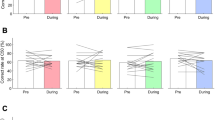Abstract
We investigated the cerebral cortical route by which visual information reaches motor cortex when visual signals are used for manual responses. Subjects responded unimanually to photic stimuli delivered to the hemifield ipsilateral or contralateral to the moving hand. On some trials, trans-cranial magnetic stimulation (TMS) was applied unilaterally over the occiput, with the aim of stimulating extrastriate visual areas and thereby modifying transmission of visual input. In association with the side of a visual stimulus and a motor response, TMS could change inter- or intra-hemispheric transmission needed to convey visual information to motor areas. Reaction time differences following TMS suggested that TMS exerted an inhibitory effect only when visuo-motor information had to be transferred interhemispherically. This result reinforces evidence for an extrastriate pathway of interhemispheric transfer of visuomotor information.
Similar content being viewed by others
Author information
Authors and Affiliations
Additional information
Received: 17 July 1997 / Accepted: 29 September 1997
Rights and permissions
About this article
Cite this article
Marzi, C., Miniussi, C., Maravita, A. et al. Transcranial magnetic stimulation selectively impairs interhemispheric transfer of visuo-motor information in humans. Exp Brain Res 118, 435–438 (1998). https://doi.org/10.1007/s002210050299
Issue Date:
DOI: https://doi.org/10.1007/s002210050299




